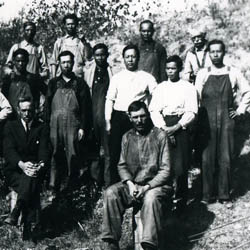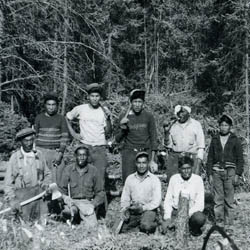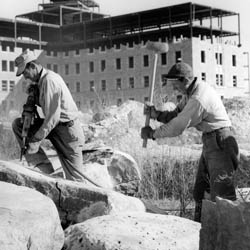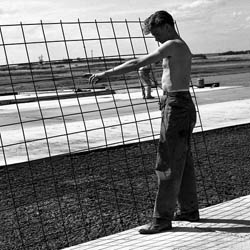Construction or building is one of Saskatchewan's most vital industries. In June 2009, 40,600 Saskatchewan residents were employed in the construction industry, only 4,000 less than those employed in agriculture. Construction projects fall into three main types: residential, including individual houses, condominiums, and apartment buildings; institutional, commercial and industrial, including schools, hospitals, stores, offices and factories; and large scale engineering projects including railroads, highways, bridges, dams and pipelines. Grain elevators, once ubiquitous across southern Saskatchewan, are well- known examples of the second type. Among the largest of the last type is the South Saskatchewan River project which included the building of the Gardiner Dam, one of the world's largest earth filled structures.
There are many different careers available in or related to the construction industry. At the beginning of projects are managers, surveyors, architects, and engineers of several types. Worksite employees include a variety of skilled tradesmen including carpenters, bricklayers and masons, electricians, plumbers, plasterers and painters. Lesser skilled general labourers also find work at construction sites.
In Saskatchewan many in the construction trades have been organized by unions and wages compare well to those in other industries. Unfortunately for workers and for construction companies, the industry is highly cyclical and subject to wide and unpredictable swings in demand. The construction industry is three times as volatile as the service sector and nearly 50 percent more volatile than the manufacturing sector. Given this volatility both workers and owners need to adjust to boom or bust environments.
Governments play a large role in the construction industry both as regulators and clients. Governments fund most of the nation's infrastructure development and maintenance and account for one-third of non-residential construction activity. A common government response to economic recessions and depressions is the encouragement of construction activity by tax rebates, incentives to new home buyers, and investments in public works. During the 1930s economic depression work for many unemployed Saskatchewan men was provided by such make-work projects as the building of Regina's Albert Street Bridge and Saskatoon's river weir.
Government investments in building infrastructure are not always so successful. In 1912 the civic leaders of Prince Albert undertook the construction of a massive hydroelectric power plant on the North Saskatchewan River downstream from the city at La Colle Falls. The goal was to attract business by the provision of cheap electricity. Construction was halted and then abandoned in 1914 when the city's economic boom collapsed at the beginning of the First World War. The failed project created an enormous debt that nearly bankrupted the city.


![Road Making Outfit Near Prince Albert, ['ca. 1910s']](cropthumbs/R-A1719-2.jpg)


![Construction of the Barry Hotel, Saskatoon, SK., ['191--?']](cropthumbs/S-COS-21_1.jpg)
![New Elevator Under Construction, Estevan, ['ca. 1910s']](cropthumbs/MG289-sent.jpg)
![Workers in Front of Knox Church, ['between 1912 and 1914']](cropthumbs/LH-3158.jpg)


![La Colle Falls Project Construction, ['1912-1913']](cropthumbs/E-94-3-p01.jpg)
![Construction of the Canadian Northern <br />Railway Bridge at Prince Albert, ['1908-1909']](cropthumbs/MG289-gate-43.jpg)
![Road Crew Working on Prince Albert Street, ['ca. 1915']](cropthumbs/MG289-gate-52.jpg)